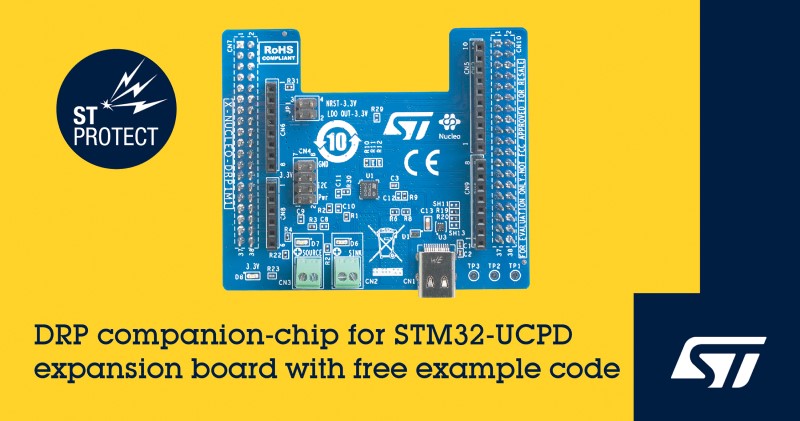STMicroelectronics New Port-Protection IC for STM32 Micros
The TCPP03-M20 USB Type-C port-protection IC is designed for Dual-Role Power applications
The new TCPP03-M20 USB Type-C port-protection IC from STMicroelectronics is designed for products that can act as a power source for connected devices as well as accepting power from other USB-C sources.

When used together with the STM32G0*, STM32G4, STM32L5, and STM32U5 microcontrollers that contain ST's UCPD (USB Type-C and Power Delivery) interface IP, the TCPP03-M20 allows a cost-effective partitioning of the USB Type-C implementation. Product designers can achieve a simple two-chip solution with the STMicroelectronics STM32 as the host microcontroller, saving on the bill-of-materials costs, PCB space, and circuit complexity.
As defined in the USB Type-C specification, a USB-C dual Role devices, such as smart speaker, smartphone, tablet, laptop or camera have the ability to dynamically change their power role from sink to source as well as their USB data role from device to host (and vice-versa). This enables new use-cases to preserve and share energy between battery-powered devices, as well as to extend device interoperability. The USB DRP capability defined in the Type-C specification allows any USB devices with the ST chip inside to charge the battery of a connected device.
Optimized for ultra-low power consumption, the TCPP03-M20 is dedicated to the USB DRP use case to ensure optimum efficiency. Standalone Power Sink and Power Source applications are handled using ST's TCPP01-M12 and TCPP02-M18 BCD ICs respectively. The TCPP03-M20 is compliant with the latest features of the USB-C PD specification 3.1 Standard Power Range (SPR), including PPS (Programmable Power Supply).
The TCPP03-M20 is built with STMicroelectronics BCD process, recently accredited as an IEEE Milestone, to combine logic and high-voltage circuitry on the same chip, enhancing integration and reliability. The technology enables ±8kV ESD protection (IEC61000-4-2 Level 4), over-voltage, and over-current protection to be implemented on the same chip. These are needed to guard against unintended short-circuits or connection of defective equipment and comply with the USB-C Power Delivery specification. The chip integrates switches for the USB-C port VCONN and CC lines, a charge pump with two N-channel MOSFET gate drivers for Source and Sink power path, VBUS and VCONN power-path discharge circuitry, and dead-battery management.
Key Features of the TCPP03-M20 USB-C Dual Role Power IC include
- Externally programmable VBUS OVP (over voltage protection) and OCP (over current protection) for provider and consumer power paths with fast turn-off
- Two integrated N-MOSFETs gate drivers for VBUS OVP and OCP
- Very low power in “unattached” state during DRP toggling: 3 µA max. at 125 °C
- Compliant with PPS (programmable power supply) for fast charging, up to 100 W
- Integrated discharge on VBUS and VCONN
- VBUS current sense and amplifier with analog output
- ESD protection for CC1, CC2, compliant with IEC 61000-4-2 Level 4 (±8 kV contact discharge, ±15 kV air discharge)
- VCONN OCP (100mW max), OVP (6V max)
- Over voltage protection on CC lines against short-to-VBUS
- Over temperature protection (150 °C typ.)
- Integrated “Dead Battery” management
- I²C communication, with two I²C addresses available
- Compliant with USB-C power delivery standard 3.1, standard power range (SPR), up to 100 W
For more information on the TCPP03-M20 USB-C Dual Role Power IC, visit the ST website at STMicroelectronics TCPP03-M20 product page.
*STM32 is a registered and/or unregistered trademark of STMicroelectronics International NV or its affiliates in the EU and/or elsewhere. In particular, STM32 is registered in the US Patent and Trademark Office.
The STMicroelectronics website address is www.st.com
[Reprinted with kind permission from STMicroelectronics - Release Date 8th November, 2021]


 About Us
About Us